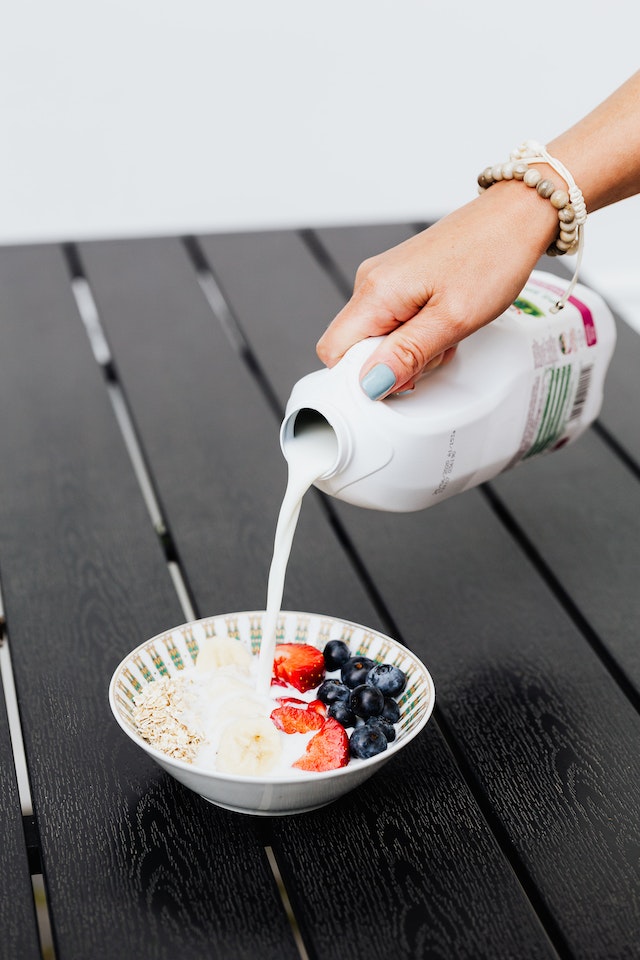Milk is a fundamental dairy ingredient that has long played an essential role in cooking traditions around the world. From creamy soups and velvety sauces to luscious desserts and fluffy baked goods, its versatility makes milk an indispensable component of countless recipes. Whether you are a seasoned chef or an aspiring home cook, understanding the various types of milk and how to incorporate them into your culinary creations is key to achieving satisfying and flavorful results

Benefits of Whole Milk in Cooking
Whole milk is a versatile and valuable ingredient in the world of culinary arts. Its use extends far beyond a simple glass to accompany your meal. When employed thoughtfully in various recipes, whole milk brings a host of benefits that enhance the overall quality of dishes.
Creaminess and Richness
Whole milk is appreciated for its creamy texture, making it an excellent choice for recipes that require a rich, indulgent mouthfeel. The fat content in whole milk contributes to its creaminess, adding a luscious quality to soups, sauces, and desserts.
In baking, whole milk plays a crucial role in creating moist, tender, and flavorful desserts. Cakes, muffins, and custards are notably improved with the use of whole milk, providing a delightful eating experience.
In savory cooking, whole milk is essential for crafting sumptuous, silky sauces. It can be used as a base for classic béchamel or white sauce, elevating dishes like macaroni and cheese or lasagna to a new level of luxury.
Enhancing Flavor and Texture
Whole milk has a neutral flavor, allowing it to serve as a vehicle for other flavors in your recipes. It enhances the taste of ingredients like cheese, herbs and spices, without overpowering them. Whole milk contributes to the desirable texture of various dishes. In mashed potatoes, it makes them creamy and smooth. In bread and rolls, it results in a soft crumb, while in pie crusts, it helps achieve a flaky, tender pastry. It helps maintain balanced moisture in baked goods, ensuring they remain delectable and enjoyable over time. Its addition prevents desserts from drying out and keeps them fresh.
Nutritional Value of Whole Milk
- Nutrient Density: Whole milk is nutritionally rich, providing essential nutrients like calcium, vitamin D, and protein. These nutrients support the overall health and well-being of individuals.
- Balanced Fat: The moderate fat content in whole milk provides a sense of satiety and contributes to the feeling of fullness after a meal. This can be especially satisfying in dishes like creamy soups and hot beverages.
- Protein Source: Whole milk serves as a source of high-quality protein, making it a valuable addition to recipes for those looking to increase their protein intake while enjoying the comfort of hearty dishes.
Whole Milk in Savory Dishes
Whole milk is a secret weapon in the savory side of the culinary world, where its rich and creamy characteristics lend themselves to a wide array of delightful dishes. From velvety soups to indulgent pasta sauces, whole milk plays a pivotal role in creating savory masterpieces that satisfy both the palate and the soul.

Creamy Soups and Sauces
Luscious Cream Soups: Whole milk is an essential ingredient in the creation of creamy soups. Its natural creaminess and fat content contribute to a velvety texture that can transform humble ingredients into indulgent comfort dishes. Classic examples include creamy tomato bisque, potato leek soup, and mushroom velouté.
Roux-Based Sauces: Whole milk serves as the base for classic roux-based sauces, such as béchamel or white sauce. These sauces form the foundation for a myriad of dishes, including macaroni and cheese, chicken pot pie, and lasagna. The creamy, smooth consistency achieved with whole milk enhances the overall quality of these dishes.
Mashed Potatoes and Gratin Dishes
Mashed Potato Magic: Whole milk is a key component in creating the creamiest mashed potatoes. Its richness and smoothness transform potatoes into a side dish that’s both decadent and satisfying. The balanced moisture ensures that your mashed potatoes are not too dry or too watery.
Gratin Excellence: Scalloped potatoes and gratin dishes benefit from the use of whole milk. The creaminess of whole milk creates a harmonious union of flavors and textures in dishes like au gratin potatoes and creamy spinach gratin.
Pasta and Baked Dishes
Pasta Perfection: Whole milk is a vital ingredient in creamy pasta dishes. It provides the base for Alfredo sauce, a velvety accompaniment to fettuccine or linguine, as well as other pasta sauces like carbonara or garlic cream. The fat content in whole milk adds richness to the sauce without overwhelming the pasta.
Baked Comfort: Whole milk contributes to the richness of baked dishes, whether it’s a hearty quiche or a comforting chicken and dumplings casserole. Its creamy quality enhances the overall experience of these savory delights.
Whole Milk in Baking
Baking is an art of precision, where the right ingredients can make the difference between a good result and a great one. Whole milk, with its unique properties, plays a significant role in enhancing the texture, flavor, and overall quality of baked goods. It’s a staple in the world of baking, offering a variety of benefits in a wide range of sweet and savory creations.
Cakes, Cupcakes, and Muffins
Moisture and Tenderness: Whole milk contributes to the moistness and tenderness of cakes, cupcakes, and muffins. It ensures that these treats remain fresh and delightful, even days after baking.

Flavor Enhancement: Whole milk has a neutral flavor, allowing it to enhance the taste of other ingredients without overshadowing them. This makes it an excellent choice for recipes that rely on the subtleties of flavor.
Texture Improvement: The richness of whole milk results in a tender crumb texture. It creates a soft, satisfying mouthfeel in cakes, ensuring each bite is a delightful experience.
Creamy Custards and Puddings
Whole milk provides a smooth and creamy consistency to custards and puddings. Its rich character elevates the overall quality of these classic desserts. In custard-based desserts, the flavor of whole milk works in harmony with other ingredients like vanilla, chocolate, or caramel. The neutrality of whole milk allows the primary flavors to shine. Whole milk can be used to make a wide range of custard and pudding variations, from silky crème brûlée to comforting rice pudding. Its role in these desserts is to ensure they are irresistibly indulgent.
Flaky and Tender Pie Crusts
Perfect Pie Crusts: Whole milk contributes to the tenderness of pie crusts, allowing for a flaky and delicate texture. It ensures that the crust complements the fillings, enhancing the overall pie experience.

- Balanced Moisture: Whole milk helps maintain the right balance of moisture in pie dough, preventing it from becoming too dry or too sticky. This balance results in a crust that’s easy to work with and bakes to perfection.
- Versatile Use: Whole milk can be used in both sweet and savory pie crusts. It provides a versatile foundation for a wide range of pies, from sweet fruit pies to savory quiches.
Substituting Whole Milk in Recipes
While whole milk is a versatile ingredient, dietary preferences, allergies, and health considerations may necessitate the use of milk alternatives or lower-fat options. Understanding how to effectively substitute whole milk in recipes is essential for accommodating various needs without compromising on flavor or texture.
Low-Fat and Skim Milk Alternatives
1% Milk: 1% milk, also known as low-fat milk, contains significantly less fat than whole milk. It can be used as a substitute in most recipes without a significant impact on texture or flavor. It’s a suitable choice for those looking to reduce fat intake while retaining the creamy quality of milk.
Skim Milk: Skim milk, with its minimal fat content, can be substituted for whole milk in recipes where fat is less critical, such as in certain baked goods. Keep in mind that it may result in slightly drier outcomes, so consider making adjustments to maintain moisture.
Plant-Based Milk Alternatives
- Almond Milk: Almond milk is a popular plant-based alternative. It has a mild, slightly nutty flavor, making it a versatile choice in both sweet and savory recipes. Use it as a 1:1 substitute for whole milk in most recipes.
- Soy Milk: Soy milk has a neutral flavor and a protein content similar to dairy milk. It can be used as a direct replacement for whole milk, making it a preferred option for many dairy-free recipes.
- Oat Milk: Oat milk is known for its creaminess and mild sweetness. It works well as a substitute for whole milk in a wide range of recipes, including baked goods and creamy soups.
- Coconut Milk: Coconut milk, especially the canned variety, is rich and creamy. It’s a great option for recipes that benefit from a hint of coconut flavor, such as curries and tropical desserts.
- Cashew Milk: Cashew milk is another creamy plant-based option that’s well-suited for baking and cooking. It provides a mild, neutral taste.
- Rice Milk: Rice milk is a neutral, nut-free option, making it suitable for those with nut allergies. It can be used in most recipes as a substitute for whole milk.
- Hemp Milk: Hemp milk has a slightly nutty flavor and is a good source of omega-3 fatty acids. It can be used in various recipes, including smoothies, baked goods, and sauces.
When substituting whole milk with milk alternatives, it’s important to consider the flavor and consistency of the substitute, as it may affect the final taste and texture of your dish. Be prepared to adjust the recipe as needed to achieve the desired results, and keep in mind that some milk alternatives may be sweetened or flavored, which can impact the overall taste of your creation.
Culinary Tips and Best Practices
Working with whole milk in your culinary endeavors requires attention to detail and some expert techniques to ensure the best results. These tips and best practices will help you harness the full potential of whole milk while enhancing the flavor and texture of your dishes.
Storing and Handling Whole Milk

Refrigeration: Whole milk should be stored in the refrigerator at a temperature of 32-40°F (0-4°C) to maintain its freshness. Keep it in its original, airtight container, and check the expiration date regularly.
Shake Before Use: Whole milk can separate over time, with fat rising to the top. Be sure to shake the container well before pouring to distribute the fat evenly.
Check for Spoilage: Before using whole milk, always check for signs of spoilage, such as off smells or unusual curdling. If you notice any of these, discard the milk.
Preventing Curdling and Scorching
Tempering: When adding whole milk to hot mixtures, like sauces or soups, temper it first by gradually incorporating a small amount of the hot liquid into the cold milk. This helps prevent curdling.
Stir Continuously: While heating milk-based sauces or custards, stir continuously to prevent sticking or scorching. Use a heavy-bottomed pan to distribute heat evenly.
Low Heat: When using whole milk in recipes, especially when making sauces or custards, use low to medium-low heat to avoid overheating and curdling.
Adjusting Recipes for Dietary Preferences
If you or your guests have dietary restrictions, be prepared to make substitutions as needed. Use low-fat milk or plant-based milk alternatives in recipes to accommodate specific preferences or dietary requirements.
Taste your recipes as you go to ensure they meet your flavor and texture expectations. Adjust the seasoning and sweetness levels as necessary when using whole milk substitutes. If you’re making a recipe that typically calls for whole milk but want to reduce the fat content, consider blending whole milk with a lower-fat alternative to achieve a balance between creaminess and health-conscious choices.
With these culinary tips and best practices, you can make the most of whole milk in your cooking and baking endeavors. Whole milk’s richness and flavor-enhancing properties, combined with careful handling and adjustments for dietary needs, will help you create dishes that are not just delicious but also tailored to your exact preferences and dietary requirements.
